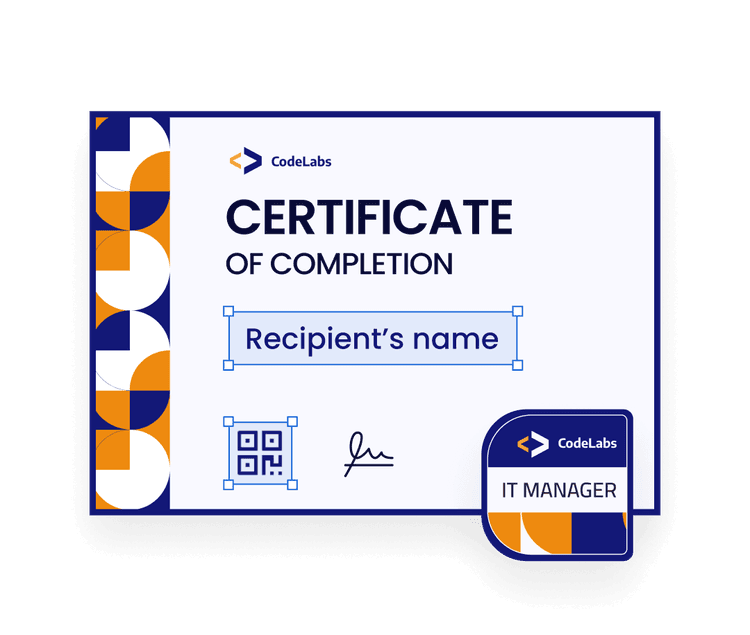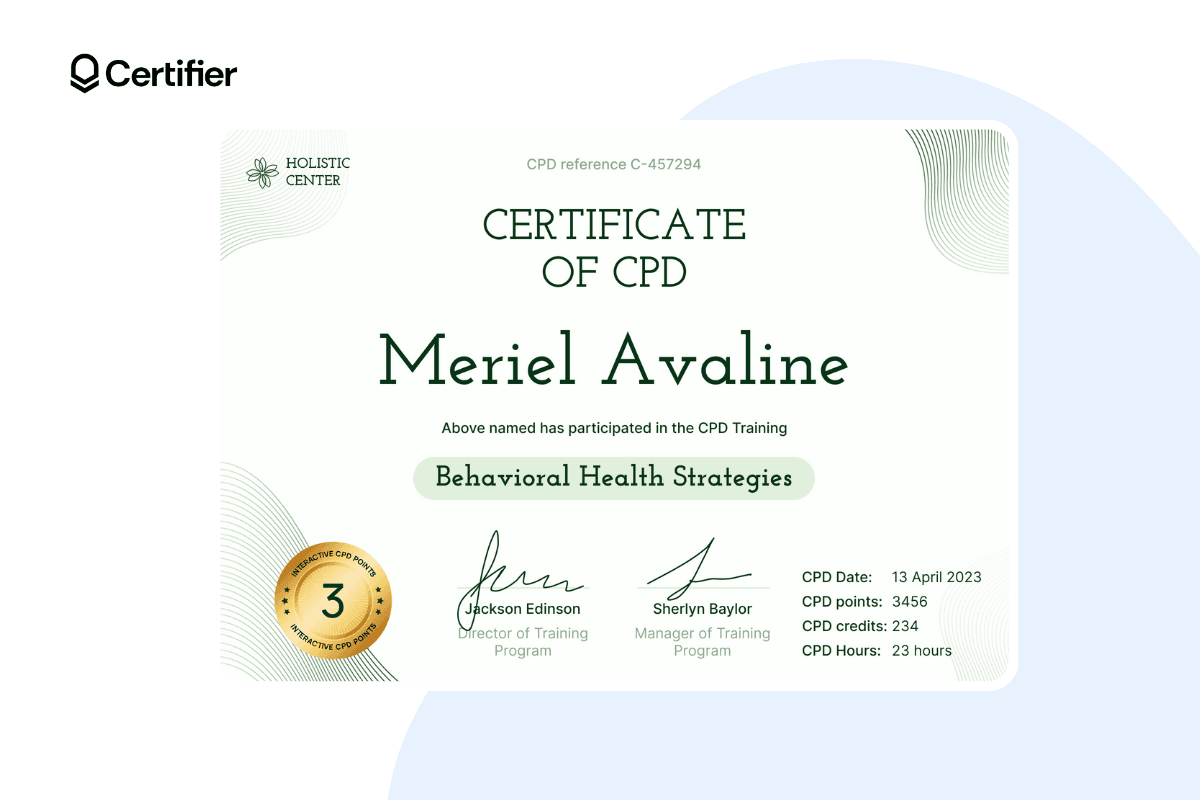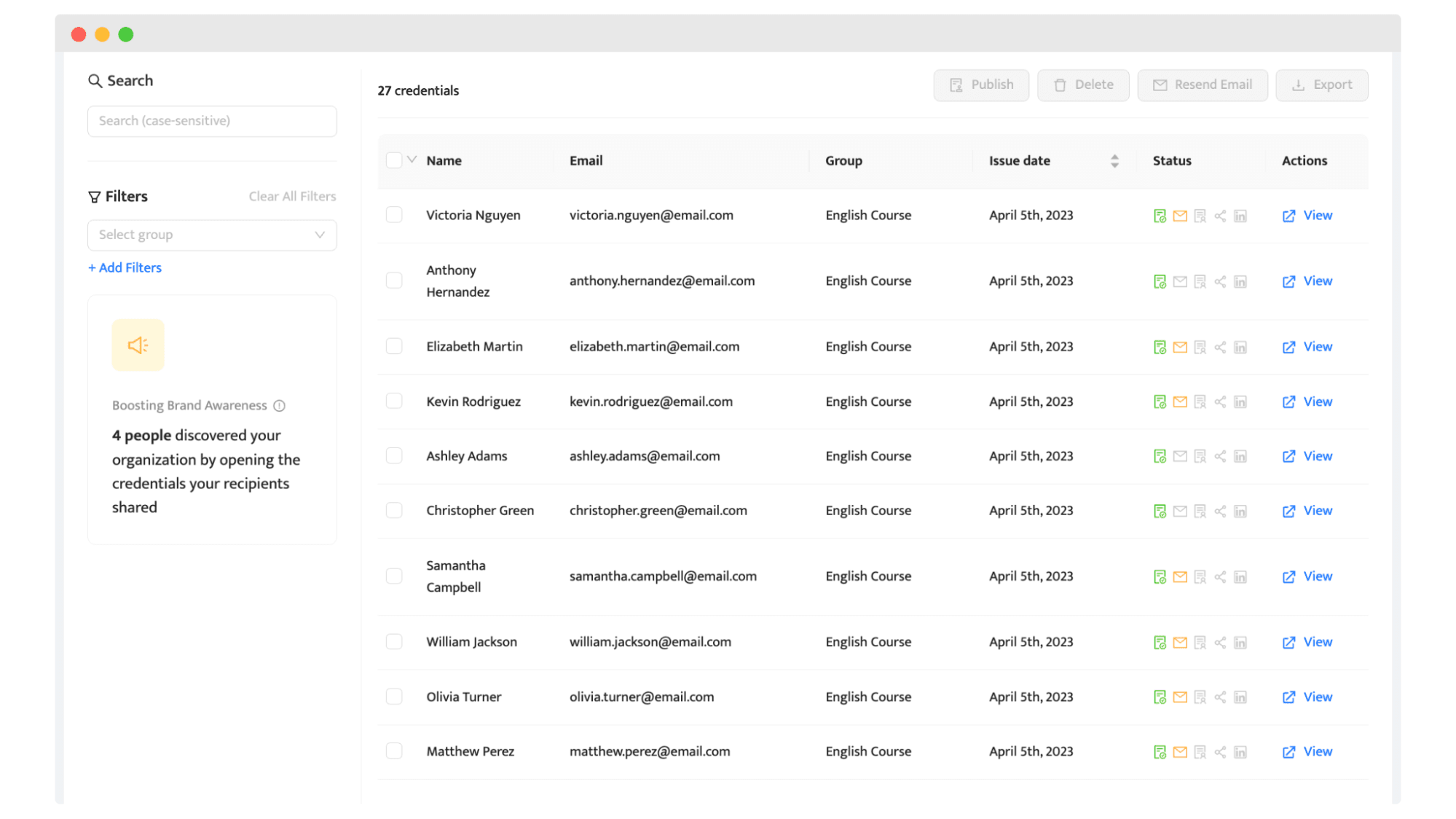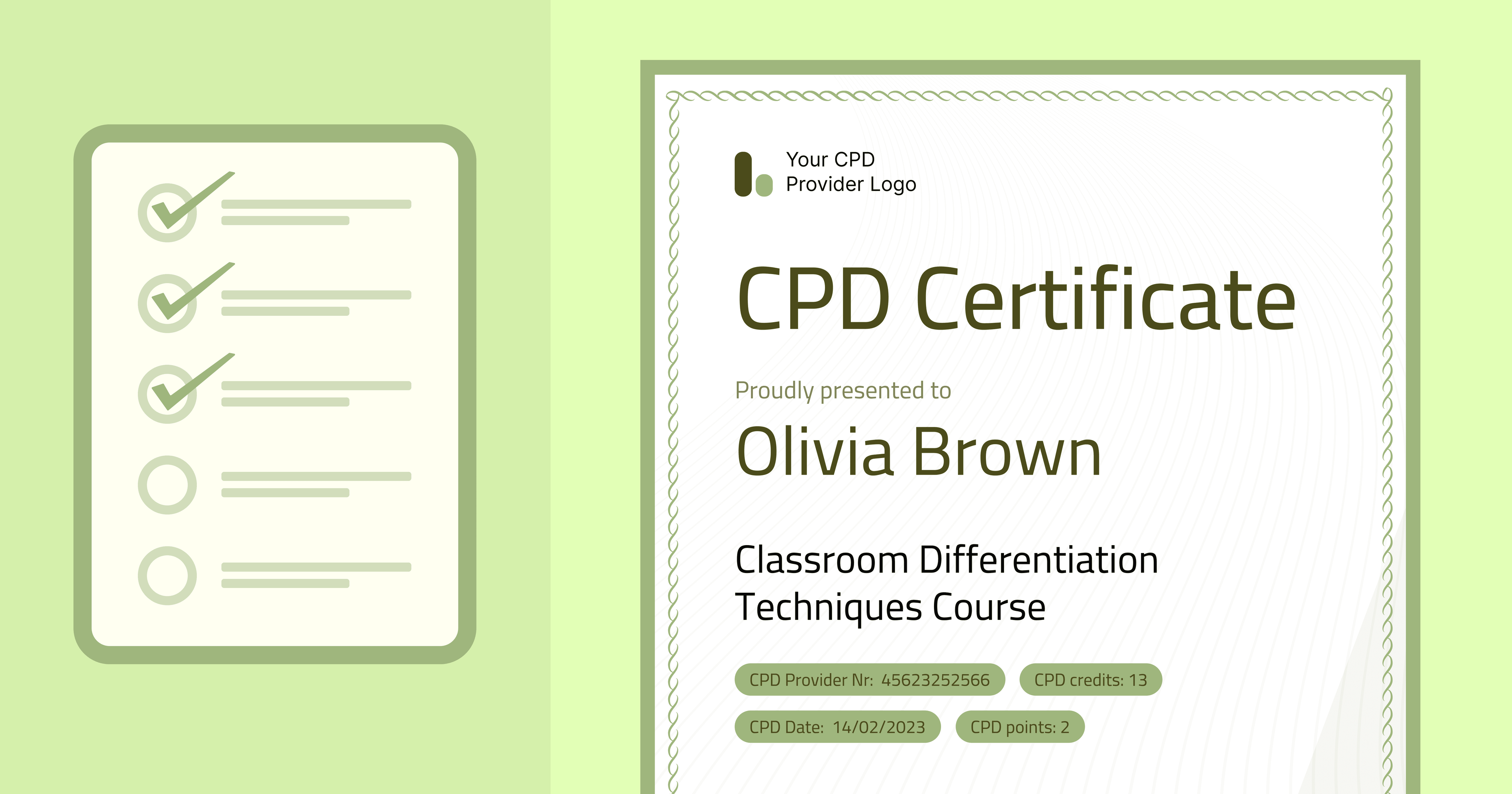Trusted by:
Updated: June 12, 2025
7 min read
9-Step Checklist for CPD Certification Course
Find out how to create a stellar CPD certification course, step by step. Expert tips and actionable tools are included. Check off the next tasks on your list before the course goes live.
Every successful CPD certification course should begin with a solid plan. Though let's be honest, it's a step many just overlook (and that's your chance!).
Crafting a CPD course demands real thought, a sharp eye for detail, and truly getting into your participants' heads. What's the end game? To build a program that's as rewarding as it is educational.
This guide's got your back, walking you through a checklist packed with all the tools you need to put together a continuing professional development course.
But just to make things clear, let’s start with the CPD certification meaning.
🤔 What is a CPD certification? CPD (continuing professional development) certification serves as proof of structured learning. CPD certification means the recognition of professional training that meets industry standards.
1. Define learning outcomes
Identify what you want your CPD participants to gain from your course.
It's like setting the destination for a road trip. You wouldn't just jump in the car and start driving without knowing where you're headed, right? The same goes for your CPD certified course.
Start by asking yourself: What should participants know or be able to do when they're done?
Be specific and realistic. "Understanding the basics of project management" or "Being able to create a budget spreadsheet" are good examples.
Make your outcomes SMART – Specific, Measurable, Achievable, Relevant, and Time-bound. As a result, they are clear, focused, and most importantly – doable.
Here’s the pro tip: The best learning outcomes are participant-centered. Put yourself in your attendees’ shoes and think about what success looks like from their perspective. After all, this course is for them, not you.
So, take your time, think it through, and set those clear, actionable goals. Your participants (and future you) will thank you for it.
2. Develop a compelling training program
Now that you've set clear learning outcomes, it's time to fill your course with relevant content. There are two main tips:
Mix your training program with a variety of learning activities. There should be something for everyone, from interactive online courses to practical exercises. People have different learning styles, so a generic approach to learning just won't work.
Encourage self-directed learning activities and provide resources for ongoing development. Provide all your participants with the tools they need to succeed.
Note: Work closely with professional bodies to make your CPD content accreditation compatible. It boosts the credibility of your CPD certified course and guarantees it's relevant to current job roles and the path to success in various industries.
> View the link for details on how to provide CPD-accredited programs.
And here’s a little secret. The best content feels like it’s speaking directly to the participant. So, get personal. Tailor your content to fit their professional qualifications and career development goals. Ask your participants about these aspects.
Their current role and responsibilities.
Specific challenges they face in their work.
Areas where they feel they need more knowledge or skills.
Their long-term career aspirations and goals.
Previous training or professional development experiences.
3. Choose a reliable certification software
Effective CPD course needs integrated workflow and automation tools. The right CPD course software can make all the difference and should be at the top of your toolkit priority list.
According to the latest Coursera reportt, 90% of students or recent graduates say that earning a professional certificate will help them get hired in a competitive job market.
It confirms that learning and recognition go hand-in-hand – so your participants want to end your CPD course with tangible proof of their achievements.
That's why finding the right certification software is so important. Here are the features you should look for in such a certification tool.
Straightforward and user-friendly interface.
Customizable templates.
Hassle-free distribution of certificates.
Ability to verify the authenticity of the certificates.
Alignment with industry certification standards.
We already knew the tool that covers all the points on this list. Let’s talk about Certifier.
Create and Send Digital Credentials

This certificate maker is among the best certification software on the market. Since April 2023, Certifier has been the CPD Standards Office partner. It's user-friendly, offers a bunch of customizable templates, and provides a dashboard with a clear overview of distribution and verification. Choosing a Certifier means choosing ease, quality, and credibility for your CPD program (and it has a feature-rich free plan). You don't need to look any further than that.
4. Set certification criteria
CPD professional courses must tick certain boxes to meet accreditation industry standards and get assigned to this course category. That's why setting your certification criteria upfront is non-negotiable. It sets the stage for what participants must achieve to earn their certificate.
And makes sense for two reasons – legal perspective and the coherent learning experience for all involved.
Certification criteria are a surefire way to maintain the high-quality CPD programs are known for.
So, what’s the game plan?
Pinpoint the specific accomplishments or skills participants should demonstrate by the end of the training course. What are the must-haves for them to complete the program? It could be anything from mastering a specific skill to participating in all learning activities.
Lay out your criteria in simple, straightforward terms. Clarity is key. Communicate them clearly. Avoid jargon and complex language. You want everyone to know what’s expected of them. No confusion allowed.
Be sure that each criterion directly relates to the course's learning outcomes and overall goals. It shows that your criteria are not just random hoops to jump through but meaningful milestones on the participants' learning journey.
This approach clears things up for all participants. It keeps them on track and highlights why the CPD certified course is worth their learning time and effort. The result is fair and effective assessment methods in your CPD training courses.
5. Provide support and resources
Think about what makes a company really stand out. One of the factors is unbeatable customer service. Just like how it sets a company apart from its competitors, the same principle applies to educational providers.
Your participants are the heart and soul of your CPD training courses. They’re not just names on a list but real people looking to learn, grow, and get the most out of your course. And they deserve the best treatment.
Be there for them. Create a space where they can ask questions and share their thoughts. Whether you reach out to them by phone, email, or discussion board, let them know you are listening.
Give them the tools and practical skills they need to make the most of the course. Share articles that make them think, videos that break things down, and templates that guide them through the tricky training challenges.
In short, treat your participants like the exclusive range of customers. Because, just like in the business world, great service in education counts for a lot.
6. Automate certificate generation
The CPD certification process should be as smooth as possible.
Achieving that starts with planning and equipping yourself with the right tools. Consider how much time you'll save if you integrate automation features to create and send certificates.
You can finally forget about the boring stuff like typing out names and sending tons of emails one by one.
Certifier grabs the information straight from a Google Spreadsheet and, in seconds, creates dozens of certificates. There is no complicated process to follow.
Choose the CPD certificate template from Certifier's expert-designed collection of customizable templates. Pick the one that fits your vibe, and you’re halfway there.

Set up dynamic attributes. They’re a dynamic range of elements that you can use to create and personalize certificates. For example, add the recipient’s name or the points they scored.
Create a group of recipients and pull out the data from Google Spreadsheet.
Use the preview feature to make sure everything’s looking sharp, and with just one click, send those certificates straight to your participants.
Automation is more than just a speedy solution. It allows you to keep everything on track and free up your time for things that require your presence.
7. Schedule regular staff training sessions
If you want your CPD training courses to be exceptional, you’ve got to make sure your crew is up to speed and feeling confident. There's always room to learn new things, whether industry standards or teaching techniques. And that means regular training sessions are a must.
Make staff training a mix of self-directed learning activities and structured learning so everyone can develop in a way that suits them best.
And don't forget about the soft skills. Communication, teamwork, and leadership are all critical parts of professional skills that can make or break your level of service.
Get those training sessions on the agenda to fill in those knowledge gaps and boost personal and professional skills. Make them engaging, informative, and relevant to your team's needs. Show them you're invested in their growth and that you're all in this together.
8. Monitor the certification process
As you have launched new CPD courses, you can't just set them up and hope for the best. It is crucial to monitor the certification process at each stage.
Here's why.
Let's say you've got participants from a wide variety of roles, from industry professionals to those looking to 're-skill' themselves. Are they all receiving the same level of service? Have there been any hiccups? Are some participants struggling with specific modules while others breeze through?
Keeping an eye on the certification process can help you spot these issues early on. For example, if you use the Certifier dashboard, you can easily detect that somebody didn’t receive the certificate. It helps you to react quickly and resend the email.

Quick reminder: Certifier also allows you to track certificate statuses such as bounced emails, opened emails, engagement, or LinkedIn shares (potential promotion is coming!).
Here are some more actionable tips to help you effectively monitor the CPD certification course.
Use tools and platforms that allow you to monitor the process.
Schedule regular check-ins to maintain compliance with the required training standards.
Encourage participants to provide feedback.
Observe current trends in education. Institutions like the University of Oxford have resource hubs with informative tutorials and research.
9. Test, learn, and develop
As a training provider, you must know that maintaining CPD courses at the highest level requires constant work. And that means constantly testing, learning, and developing your courses.
Say you notice that many participants are dropping off at a particular module. That’s a red flag. Maybe the content is too complex, or perhaps it’s not engaging enough. It’s your chance to learn and understand what’s going wrong. Talk to your participants, ask for feedback, and listen to what they say.
Take what you’ve learned and use it to make your CPD certified course better. Test and try which solutions work best. Remember, the goal is to create a learning experience that’s informative and enjoyable.
All of this isn’t a one-time job. It’s an ongoing thing.
You’ve got to keep testing, learning, and tweaking. It’s all about putting in the effort to make the CPD training courses the best they can be.
Key takeaways
Get your plan straight. Start off with a solid plan and targets in mind. Set SMART goals for your CPD training courses.
Think like your participants. Get to know your participants' needs and shape your course around that. Mix up the learning activities with practical qualifications and handy resources to keep things interesting.
Pick the right tool. Don’t skimp on the tools you use, especially when it comes to certification software. Certifier is a great pick. It's easy to use, provides a free plan, has tons of cool templates, and simplifies the certification process.
Set clear certification criteria. Make sure everyone knows what they need to do to get their certificate. Lay out your expectations clearly and ensure they align with the course's goals.
Keep making the CPD training courses better. Your job isn’t done once the course is up and running. Keep an eye on things, listen to feedback, and be ready to tweak and improve wherever needed.
Conclusion
With all these tips in hand, you're set to create a CPD certification course that achieves its goals. Keep it real, make it relatable, and show your participants you're truly working for them.
And hey, with Certifier by your side, you're looking at a win-win. Give Certifier a try to smooth out the certification process.
FAQ: CPD certification course
If you need some more clarification on what is a CPD certification, how to issue it, or how is the CPD certification useful – go through our answers to the most frequently asked questions.

- SaaS Growth
- Digital Credentials
- APIs
- Product Marketing
- Company Operations
CEO and Co-Founder
Sergey is CEO and Co-Founder of Certifier, a Forbes 30 Under 30 honoree building digital credential infrastructure for 2,000+ organizations worldwide and shaping the future of credentialing.


